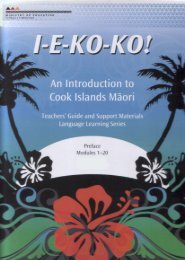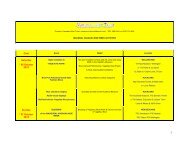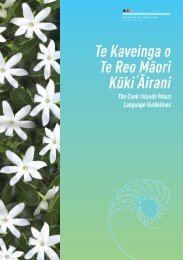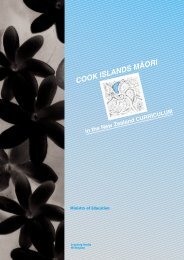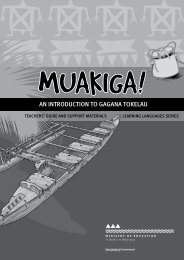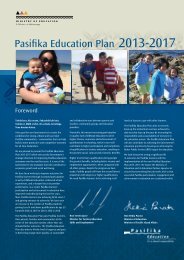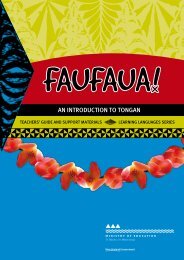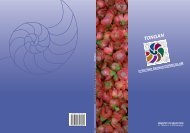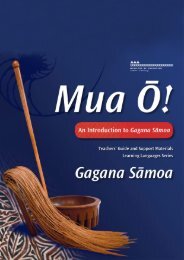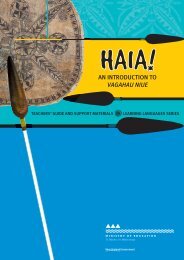Ta'iala mo le Gagana SÄmoa - Pasifika Education Community
Ta'iala mo le Gagana SÄmoa - Pasifika Education Community
Ta'iala mo le Gagana SÄmoa - Pasifika Education Community
You also want an ePaper? Increase the reach of your titles
YUMPU automatically turns print PDFs into web optimized ePapers that Google loves.
Fuafuaina o Polokalame i Ā‘ogaPlanning Programmes in SchoolsThe guidance offered for schools in Ta‘iala <strong>mo</strong> <strong>le</strong> <strong>Gagana</strong> Sā<strong>mo</strong>a: The <strong>Gagana</strong> Sā<strong>mo</strong>a Guidelines issummarised in this section as a logical series of steps for teachers to take in order to create effectiveprogrammes for teaching and <strong>le</strong>arning gagana Sā<strong>mo</strong>a and aganu'u fa'asā<strong>mo</strong>a.It is suggested that teachers:• incorporate into their planning frameworks the philosophy, aims, key competencies, and values ofThe New Zealand Curriculum, including the directions set by the Learning Languages <strong>le</strong>arning areastatement and the tab<strong>le</strong> of achievement objectives;• find ways to integrate the philosophy, aims, and values of Ta‘iala <strong>mo</strong> <strong>le</strong> <strong>Gagana</strong> Sā<strong>mo</strong>a: The <strong>Gagana</strong>Sā<strong>mo</strong>a Guidelines into their programme development;• identify the needs, interests, and prior language experiences of their students and any specialrequirements or school policies that relate to language <strong>le</strong>arning;• consider the school-wide language policy (for examp<strong>le</strong>, the sequencing of <strong>le</strong>vels, the timetablingoptions, or possib<strong>le</strong> national awards) and how this policy relates to their short-term planning (forexamp<strong>le</strong>, the term and the weekly plan);• look for opportunities to make links with programmes in other <strong>le</strong>arning areas (for examp<strong>le</strong>, art, music,and food technology) and other institutions and events (for examp<strong>le</strong>, community programmes andcultural festivals);• identify the target achievement objectives from the re<strong>le</strong>vant <strong>le</strong>vel or <strong>le</strong>vels and clarify the intended<strong>le</strong>arning outcomes and possib<strong>le</strong> dates for their achievement;• decide on suitab<strong>le</strong> themes that would be re<strong>le</strong>vant and interesting, se<strong>le</strong>cting appropriate topicswithin the themes to provide a balanced and well-sequenced <strong>le</strong>arning programme and to enab<strong>le</strong>the intended outcomes to be achieved;• consider the pedagogy that is <strong>mo</strong>st effective for introducing, reinforcing, consolidating, andextending the students’ communication skills within and beyond the classroom (for examp<strong>le</strong>,homework planning, vocabulary notebooks, and ways to be involved in the community);• se<strong>le</strong>ct (or develop) suitab<strong>le</strong> resources and <strong>le</strong>arning activities that will enab<strong>le</strong> the students to acquirespecific content (such as language structures, vocabulary, and cultural know<strong>le</strong>dge) and to combineand apply their know<strong>le</strong>dge in meaningful communication to achieve the intended outcomes;• plan to col<strong>le</strong>ct and analyse data on student achievement in order to provide students with usefulfeedback on their progress and <strong>le</strong>arning needs and to gain evidence to use in ongoing adjustmentto their programmes to ensure they continue to meet their students’ needs;• prepare summative assessments that are well aligned to the outcomes to be achieved and that canalso help students to continue to progress;• develop ways to evaluate their teaching and <strong>le</strong>arning programmes against their objectives.101



